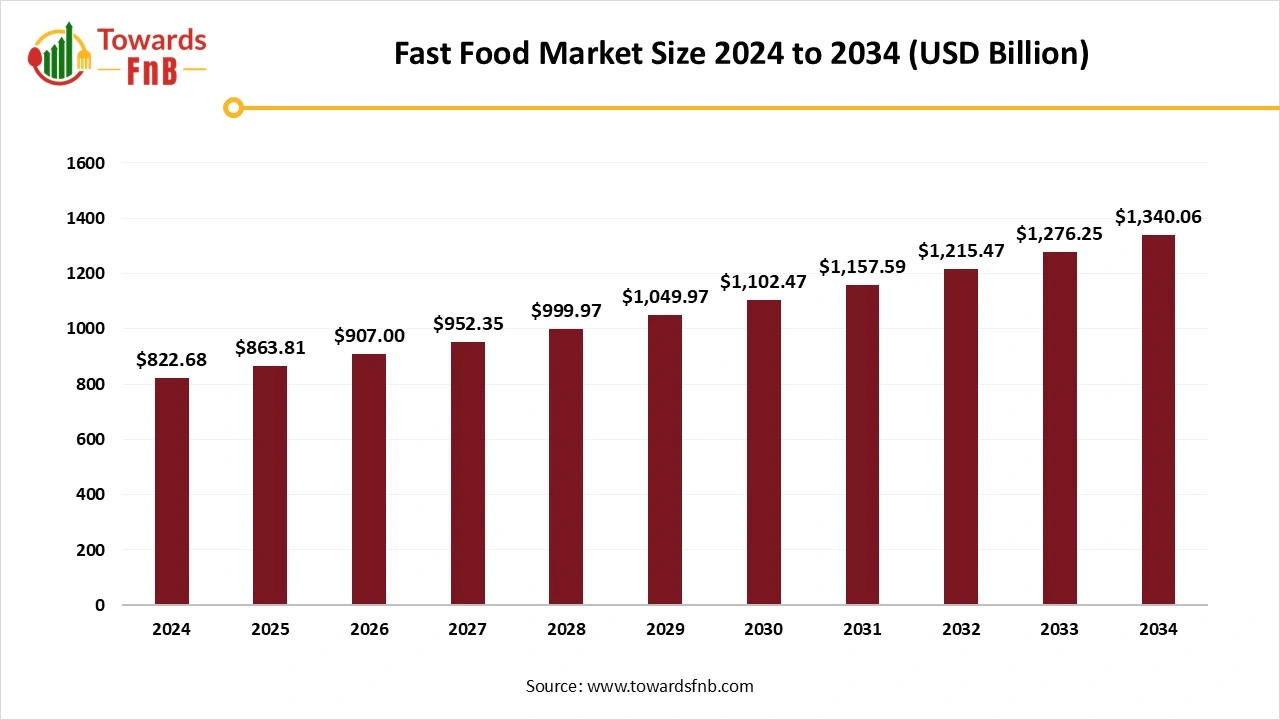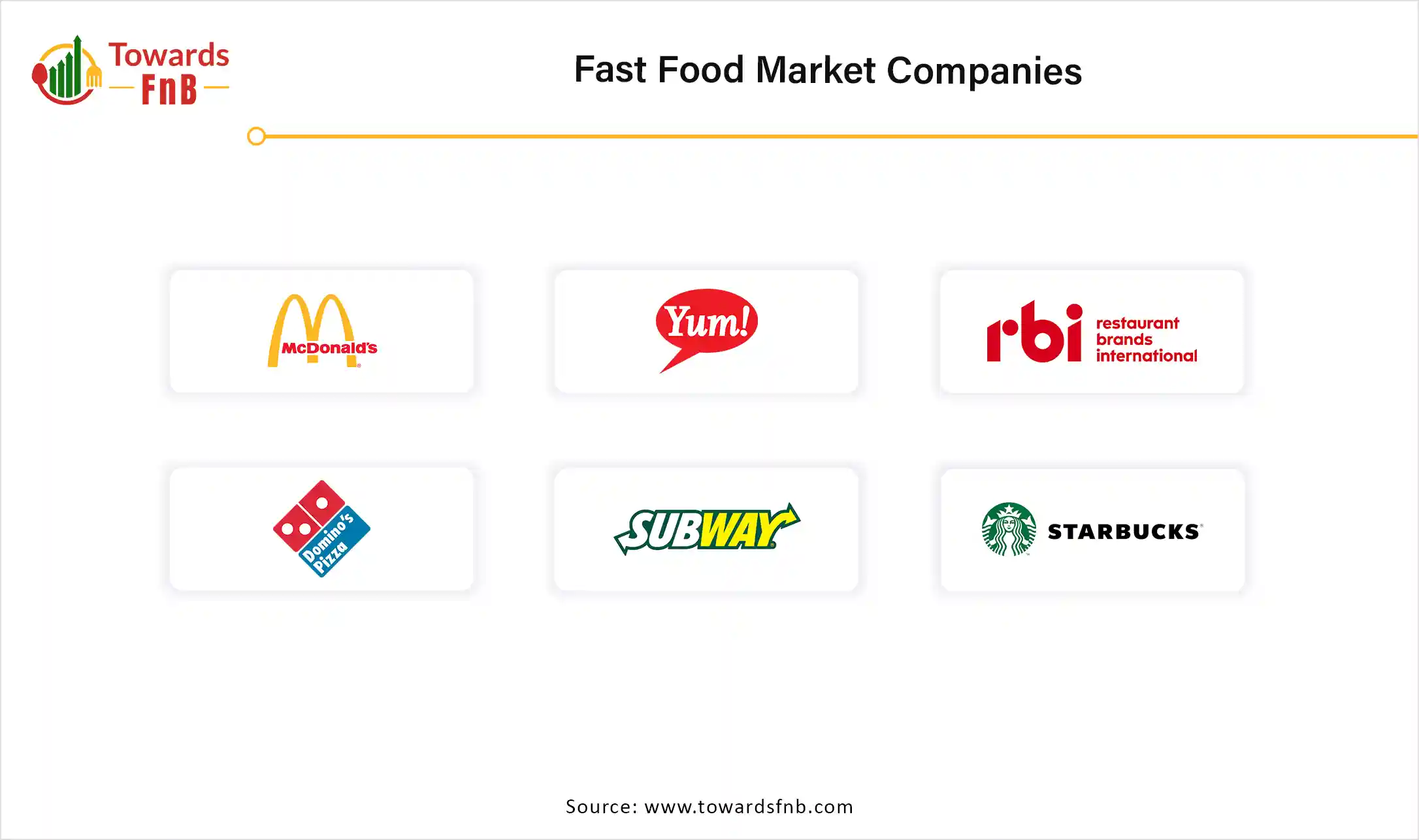November 2025
The global fast food market size calculated at USD 822.68 billion in 2024 and is anticipated to increase from USD 863.81 billion in 2025 to an estimated USD 1,340.06 billion by 2034, witnessing a CAGR of 5% during the forecast period from 2025 to 2034. The growing inclination towards the faster and convenient food options due to the busy lifestyle accelerate the market expansion.

| Study Coverage | Details |
| Growth Rate from 2025 to 2034 | CAGR of 5% |
| Market Size in 2025 | USD 863.81 Billion |
| Market Size in 2026 | USD 907 Billion |
| Market Size by 2034 | USD 1,340.06 Billion |
| Largest Market | North America |
| Base Year | 2024 |
| Forecast Period | 2025 to 2034 |
| Regions Covered | North America, Europe, Asia-Pacific, Latin America, and Middle East & Africa |
The fast food market refers to the global industry involved in the preparation and sale of quick-service food products that are typically mass-produced, pre-cooked, or semi-prepared to ensure speedy service and convenience for consumers. This market includes a broad range of food service establishments such as burger chains, pizza outlets, fried chicken restaurants, sandwich and bakery cafés, and ethnic food outlets. Fast food is characterized by affordability, standardized taste, and high consumer turnover, making it a key pillar of the global foodservice industry.
One of the major driving factors propelling the growth of the market is increasing spending on food and changing consumer preferences. The rising expansion of a variety of food service outlets is gaining popularity in developing and developed markets around the globe. The various popular brands, such as Burger King, KFC, McDonald’s, Pizza Hut, Domino’s, and many more, are widely used by consumers, which accelerates the demand for these brands. In addition, growing tourism, a rapidly growing population, and an increase in household incomes are further expected to fuel the growth of the market.
The rising technological advancements in the fast food industry is revolutionizing market growth. The new standards in fast food are rewards programmes, online ordering, and mobile apps, which are adding perks to the fast food industry. Various technologies offer a seamless app-based ordering system that improves consumer satisfaction and efficiency.
The rise of digital innovation helps the fast food industry with convenience and speed. To suggest personalized menu options, advanced data tracking enables restaurants to make every order feel comfortable. This fusion of customization and technology can help consumers experience their favorite fast food brands, which are further expected to revolutionize the growth of the fast food market in the coming years.
Consumption of fast food in huge quantities can cause various health issues, such as heart disease, digestive issues, an increase in body obesity, and other medical problems. The resulting health conditions and unsaturated fat content of fast foods can create major challenges in the global market. In addition, increasing health awareness among people is related to the harmful impacts of consuming fast food in unhealthy foods, high-calorie foods, and cholesterol, which is further expected to restrain the growth of the fast food market.
How Do North America Dominates the Largest Fast Food Market Revenue in 2024?
North America dominated the market revenue in 2024. The market growth in the region is attributed to the rising investments in the fast food industry, increasing presence of major market players, increasing consumer preference towards plant-based and vegan food products, increasing demand for budget-friendly snacks and fast food, increasing disposable incomes and increasing busy lifestyles, and popularity of fast foods. The U.S. and Canada are dominant countries driving the market growth in the region.
The U.S. dominated the fast food market in 2024, driven by the increasing spending on fast food, increasing demand for quick-service restaurants, growing working population, increasing population of single parents, and dual-income families. In the U.S., there were 5 million people employed in the industry and more than 200,000 fast food establishments in 2023. In addition, there are 83% of households are consuming weekly, and 37% of adults are consuming fast foods on a daily basis in 2025, which is further expected to accelerate the demand for the global market in the U.S.
Asia Pacific Fast Food Market Trends
Asia Pacific is expected to grow fastest during the forecast period. The market growth in the region is driven by rapid urbanization and industrialization, increasing disposable incomes, a growing working population, increasing demand for fast foods, and changing consumer preferences towards plant-based and vegan food products. China, India, Japan, and South Korea are the fastest growing countries, propelling the market growth.
India is Expected to Grow Fastest During the Forecast Period.
The market growth in the country is driven by the increasing consumer preference towards organic and clean-label food products, increasing working population, increasing demand for on-the-go snacks and ready-to-eat food, and increasing presence of quick-service restaurants. There are about 59.6% of adults consuming fast food, driven by variety and taste. India has traditionally valued home-cooked meals with diverse cultures across states and regions. The Indian market is increasing at a rapid rate and growing by 40% per year.
Why did the Burgers and Sandwiches Segment Held the Largest Revenue in the Fast Food Market in 2024?
The burgers and sandwiches segment dominated the market in 2024. The segment growth in the global market is attributed to the increasing demand for street food, busy lifestyles, increasing consumer preference towards organic and clean-label food products, and a growing working population. Burgers and sandwiches are rapidly consumed in fast food in India. One of the major food delivery brands, Swiggy, ordered 40 million burgers in 2024. Consumers from Chandigarh ordered 1146 burgers from Swiggy. Bangalore is becoming the Burger Capital of India, with orders over 6 million burgers.
The Pizza Segment is Expected to Grow Fastest During the Forecast Period.
The segment growth in the global fast food market is driven by the increasing consumer trend towards parties and celebrations, the growing number of double-income population, rising urbanization, and working population, and increasing demand for ready-to-bake and frozen pizza. Due to its easy-to-serve, affordable, and convenient qualities, pizza is a favorite and popular on-the-go option for get-togethers and last-minute meals. About 11% of pizza is consumed in the U.S., which may accelerate the demand for pizza in the global market.
What Factors Help Quick-Service Restaurants (QSRs) Segment to Grow in 2024?
The Quick-Service Restaurants (QSRs) segment dominated the fast food market in 2024. The segment growth in the market is propelled by the increasing support from delivery applications, increasing consumer spending on cafes, restaurants, and hotels, and increasing demand for quick restaurant services and fast-casual restaurants. Various consumers, especially adults, are choosing quick service restaurants such as McDonald's, Taco Bell, Subway, Starbucks, Burger King, Pizza Hut, Domino's, and others, which helps to enhance consumer experience and satisfaction.
The Full-Service Fast Food Segment is Expected to Grow Fastest During the Forecast Period.
The full-service fast food restaurants that serve customized and personalized meals in a short period of time. By using prepared food or standardized ingredients, these services can adopt quick and low-cost meals. In addition, increasing kiosk integration and digital ordering, expansion of suburban and urban areas, increasing consumer awareness towards health and wellness, increasing Gen Z and millennials' trend towards customization and experience, and increasing demand for speed and quality are further expected to drive the segment growth.
How American Cuisine Segment Dominates Fast Food Market Revenue in 2024?
The American cuisine segment dominated the fast food market in 2024. American cuisine especially includes fries and hamburgers. American food culture continues to evolve and derives from cuisines from around the globe. American food culture often combines food from different ethnicities, regions, and countries with a wide variety of cuisines to make unique dishes. In addition, one of the best parts of American cuisine is that consumers can always find some reminder of home via food, which is expected to drive the segment growth.
The Asian (Chinese, Japanese, Korean, Thai, Indian) Segment is Expected to Grow Fastest During the Forecast Period.
Asian cuisine encompasses several culinary dishes and traditions from various parts of Asia. The most popular specialties in Asia countries' restaurants across the globe are foods traditionally originating from various countries, such as India, Thailand, Korea, Japan, and China. Due to its very good and authentic taste, restaurants are open which are inspired by Asian cuisine. With an emphasis on plant-based and vegetable protein sources, most Asian specialties include enough meat, which may reduce the risk of various diseases and maintain a healthy body, which further accelerates the demand for Asia cuisine.
Why did the Non-Vegetarian Segment Held the Largest Fast Food Market Revenue in 2024?
The non-vegetarian segment dominated the fast food market in 2024. The segment growth in the global market is attributed to the increasing demand for meat and meat products, growing non-vegetarian population, and increasing demand for meat-based products, such as fried meats, grilled meats, kebabs, and chicken burgers. About 90% of people eat non-vegetarian burgers across the globe. Sales of meat-based meatballs, burgers, and wings have been rising rapidly over the last few years, which may increase the demand for non-vegetarian fast foods across the globe.
The vegetarian segment is expected to grow fastest during the forecast period. The segment growth in the market is propelled by the increasing consumer preference towards clean-label, organic, and natural fast food products, increasing consumer awareness towards health and wellness.
How do Takeaway/Drive-Thru Segment Dominates the Fast Food Market Revenue in 2024?
The takeaway/drive-thru segment dominated the fast food market in 2024. The segment growth in the global market is driven by various benefits such as flexibility in location, lower overhead costs, increased sales, faster service, and convenience for customers. These drive-thru businesses are designed to offer fast service. Without finding parking spaces and having to wait in lines, consumers can place their orders quickly and receive their purchases, which may drive the segment's growth.
The Delivery Segment is Expected to Grow Fastest During the Forecast Period.
The segment growth in the market is attributed to the growing inclination towards online shopping, increasing demand for food delivery apps, and growing e-commerce platforms. In addition, the average restaurant is currently doing about 22% of its business via online delivery services, according to the 2025 State of Restaurants Report. From delivery and online orders versus dine-in orders, restaurants see a 20% increase in check sizes. Delivery can help restaurants reach out to new consumers outside of the locals, regulars, and other customers.
Mission Barns
Good Flippin

By Product Type
By Service Type
By Cuisine Type
By Category
By Distribution Channel
By Region
The global stevia sugar blends market size is expected to grow from USD 549.60 million in 2025 to USD 1,264.46 million by 2034, at a CAGR of 9.7% over...
The global CBD edibles market size is forecasted to expand from USD 15.10 billion in 2025 to USD 38.01 billion by 2034, growing at a CAGR of 10.8% dur...
The global trail mixes market size is positioned for rapid expansion, with projected revenue increases over the next decade, spurred by the widespread...
The global liquid dietary supplements market size is projected to expand from USD 25.51 billion in 2025 to USD 54.50 billion by 2034, growing at ...
November 2025
November 2025
November 2025
November 2025